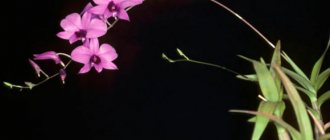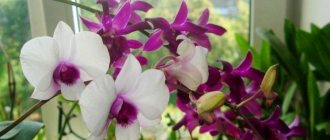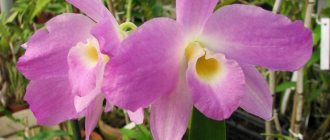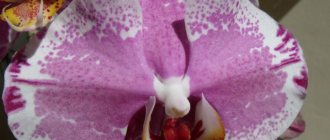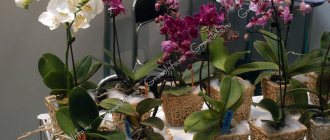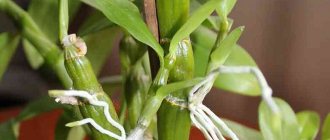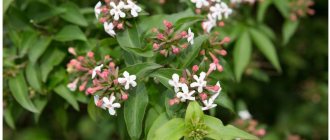Dendrobium phalaenopis is extremely popular among orchid lovers , second only to various varieties and hybrids of phalaenopsis.
Varieties and hybrids of dendrobium can often be found on store shelves; it is actively used to obtain plants with new color options. The real species Dendrobium phalaenopsis can be found infrequently, however, it is necessary to know its characteristics in order to successfully grow hybrids obtained with its participation.
Description
Dendrobium phalaenopsis forms long spindle-shaped pseudobulbs, at the top of which a peduncle is formed.
The lifespan of a pseudobulb is several years, but after the formation of a peduncle, its growth stops, and a new growth point appears at its base. This type of growth is called sympodial.
The pseudobulb bears leathery leaves , which can persist for several years, especially in the upper part, or fall off after flowering.
The arrows in the photo show the pseudobulbs of Dendrobium lindleyi.
The peduncle grows from the top of the pseudobulb and bears up to 40 flowers with a diameter of 3-5 cm , violet, lilac, white, pink or purple. In shape they resemble phalaenopsis flowers. A few paragraphs later in the article you will find a photo of the peduncle and its care.
Dendrobium phalaenopsis - Singapore orchid
- This orchid is actively bred in Asia. It has become very popular due to the fact that it is often sold as a cut. However, it has been grown as a houseplant for quite some time. Bright green thickened shoots and fleshy leaves are not inferior in attractiveness to flowers.
- Ideal temperature: 18-35 °C (day or night)
- Daily temperature changes: 3-5 °C
- Flowering duration: 1-2 months
- Flowering time: usually from January to June
- Flowering frequency: varies
- Flower colors: white, yellow, pink and purple Place: window facing south, southwest or southeast.
To make the plant more stable, place the pot in a flowerpot. Place gravel on the bottom to weigh it down and to ensure that the edges of the pot and the pot are at the same level.
Distinctive features
It is difficult to identify distinctive features, because... The height of plants, the number of leaves on pseudobulbs, their life expectancy and the color of flowers can vary greatly. All plants are characterized by leathery dark green leaves, located mainly in the upper part of the pseudobulb.
The number of leaves varies from 3 to 15, depending on the size of the pseudobulbs. At the same time, they grow on the entire stem, which is why Dendrobium phalaenopsis is often called “tree orchids” (you can see the photo below).
Dendrobium phalaenopsis.
Subtleties of classification
An interesting fact is that this species has become widely known under a name that is actually synonymous with its real name. This type of orchid was first discovered in 1852 and was named Dendrobium bigibbum, but thirty years later (in 1880) another researcher also discovered a plant of this species in another region and, not knowing about the previous discovery, named it Dendrobium phalaenopsis (Dendrobium phalaenopsis).
On a note! The term Dendrobium phalaenopsis has now become an impersonal name for a huge group of hybrids, similar in external structure, type of growth and originating from D. bigibbum. The real species name is known mainly to collectors.
Is there a difference between Phalaenopsis and Dendrobium?
The specific species name often discourages flower growers who are not familiar with the intricacies of the classification of orchids. Dendrobium and Phalaenopsis are actually 2 different genera of orchids , each with a huge number of species.
Dendrobium phalaenopsis is a member of the genus Dendrobium, and it received its specific name not because of its relationship with phalaenopsis, but because of the similar appearance of the flowers.
In addition, due to the similarity in pronunciation, dendrobium is sometimes mistakenly called “arboretum”. To avoid confusion, let's say that an arboretum is an area allocated for the cultivation in open ground of woody plants (trees, shrubs, vines), located according to systematic, geographical, ecological, decorative and other characteristics (definition from Wikipedia). That's why you will never see orchids in the arboretum, even in photos.
Watering
During the flowering period, once every ten days, immerse the pot with the plant for a few minutes in a bucket of soft water at room temperature. Then let the remaining water drain and place the pot back in the planter.
After flowering, when sprouts appear, water the orchid once a week. In case of excessive watering, the leaves of Phalaenopsis begin to turn yellow: first on adult shoots, then on young shoots.
Between waterings, spray the surface of the substrate with water once a week (more often during hot weather), especially if the shoots have filled the entire pot and sent new roots to the surface (they are very sensitive to lack of moisture). Typically, stiff stems do not need support. But if such a need arises, fasten them carefully so as not to overtighten.
External characteristics
The height of an adult plant can vary depending on the size of the pseudobulbs . In some specimens, the height of the pseudobulb does not exceed 10 cm, while in others it can reach 120 cm. If we add to this height the height of the peduncle, which can reach a length of 40 cm, it turns out that some specimens in a flowering state can be more than 1.5 m in height.
Most often you can find intermediate options. As the plant ages, the height of the pseudobulbs increases, as well as the length of the peduncle and the number of flowers on it.
The leaves are leathery, 7-15 cm long. In the lower part of the pseudoulba, the leaves are smaller and fall off quickly, and in the upper part they can persist for 2-3 years. Depending on the size, each pseudobulb can have from 3 to 15 leaves.
The peduncle can be either erect or drooping. Up to 20 flowers can form on it At the same time, in some plants several peduncles can form from the top at once.
The diameter of the flowers of the species dendrobum phalaenopsis is 3-5 cm . In the structure of the flower, the shape of the sepals, petals and lips, the dendrobium is very similar to phalaenopsis.
Dendrobium resembles phalaenopsis in flower structure.
Reproduction methods
Dividing the bush
Dendrobium orchids grown indoors can be propagated by dividing the bush. The plant is divided during transplantation after it has flowered. An adult large bush is taken out of the container and divided into parts after the root system is freed from the substrate. In this case, first you need to carefully untangle the roots, and then those that are very tangled are cut with a sharp, disinfected tool. During division, it is necessary to take into account that each division should have 2 or 3 mature bulbs and the same number of young growths. The cut areas are treated with garden varnish or sprinkled with charcoal powder.
Cuttings
Cut the pseudobulb from the parent bush and cut it into cuttings, which should be about 10 centimeters long. The cut areas are coated with garden varnish. Take a resealable plastic bag and fill it with moistened sphagnum moss. Place one or two cuttings in each bag, then zip them tightly and put them in a warm (22 to 25 degrees) and well-lit place, keep in mind that the light must be diffused. Ventilate the cuttings every day and make sure that the sphagnum moss is always moist (not wet). The cuttings will take root after 15–20 days, after which they can be planted in separate pots. The bushes grown from them will bloom for the first time after 2 or 3 years.
Dendrobium Orchid! We propagate by cuttings!
Main features of flowering
Under optimal conditions and moderate temperatures, flowering of a species plant can last from 1 to 3 months . When it comes to hybrids, flowers on some hybrid plants can stay in bloom 2 times longer.
In apartment conditions, flowering usually occurs at the beginning of spring , after a relatively dry and cool dormant period. However, hybrid plants can bloom at any time of the year.
Theoretically, each pseudobulb can bloom several times, even after it completely loses its leaves, but in species plants the peduncle is formed only from the tip of the pseudobulb, even with repeated flowering.
Interesting! In hybrid plants, in the creation of which not only D. bigibbum took part, peduncles can also form from the leaf axils in the upper part of the pseudobulb.
Stimulation
Hybrid plants, as a rule, do not have problems with flowering, but species specimens need a short period of rest , as in natural conditions.
During the dormant period, plant growth stops and new growths and roots do not form. At this time, it is necessary to keep the dendrobium drier than usual , i.e. reduce the frequency of watering and eliminate fertilizing.
Pruning after flowering
After the last flower falls, the peduncle usually dries up. Since it no longer plays any role in the life of the plant, it is cut down to the level of a pseudobulb .
After flowering, the peduncle is cut to the level of the pseudobulb.
Dendrobium orchid species
Dendrobium - the most beautiful flower
Among the variety of species and varieties of orchids, it is impossible to single out any special variety that would gain universal popularity. They are all beautiful in their own way.
Dendrobium nobile
Photo: Dendrobium nobile
Dendrobium nobile is native to Vietnam and the Himalayas. Shiny thick pseudobulbs are characterized by rapid growth and reach 0.5 m in length already in the first year of life. In the next season, flower stalks are formed, of which there are from 1 to 3 on one plant. The flowers are large, rich in color, up to 10 cm in diameter.
The natural-looking flowers are pure white, the tips of the petals are tinged with purple, the lip is cream, and the throat is dark purple in color. Hybrids have different colors and bloom several times a year.
Dendrobium phalaenopsis
Dendrobium phalaenopsis
Dendrobium phalaenopsis The orchid got its name due to the identical shape of flowers with phalaenopsis. Naturally distributed in Australia.
Pseudobulbs, together with leathery glossy leaves, reach 0.7 m in length. The species simultaneously forms up to 10 flowers, 8 cm in diameter, which are located on a high peduncle. More often the petals are painted burgundy.
Flowering is long-lasting, up to 2 months. It falls at the end of November - beginning of December. Several peduncles may appear on the same pseudobulb in one season. The best type for novice gardeners.
Dendrobium moniliforme
Dendrobium moniliforme
Dendrobium moniliforme Moniliforme is a noble dendrobium in miniature. The stem of the bush reaches no more than 15 cm in height, the rosette is very beautiful. Inexperienced gardeners should have this species at home, as it is easy to care for, especially since it blooms with beautiful “butterflies”.
Dendrobium parishii
Dendrobium parishii
Dendrobium parishii The hanging shoots of an epiphthous plant reach 0.3 m in length. There are also more powerful specimens.
The pointed oblong-lanceolate leaves grow up to 12 cm in length. Single flowers, painted in an amethyst-purple tone, bloom on the dendrobium. The rounded lip is densely strewn with purple-brown spots, the anther is purple, the column is snow-white. Characterized by summer flowering.
King's Dendrobium (Dendrobium kingianum)
Dendrobium kingianum
King's Dendrobium (Dendrobium kingianum) Native to Australia. The lower part of the cylindrical stems has a noticeable thickening, and at the top of the stem there are wide leaves.
Flowering is abundant, buds are formed in large quantities, in February. At this time, the King's dendrobium produces a long peduncle, on which 5 pink flowers bloom, exuding a pleasant aroma.
Dendrobium densiflorum
Dendrobium densiflorum
Dendrobium densiflorum is found naturally in the Himalayas. Unusual coloring. All flowers have a rich orange color, which even slightly hurts the eye. Flowering is very abundant. Up to 50 flowers can bloom simultaneously on racemose inflorescences 0.3 m long.
You can learn more about representatives of the orchid family from the video below.
Features of care
Dendrobium phalaenopsis is quite unpretentious and, subject to optimal maintenance conditions, does not cause significant trouble to the owner . Hybrids tolerate indoor conditions quite well.
Optimal conditions for keeping
This species and the hybrids obtained from it are classified as warm-keeping . In the natural habitat, the climate is quite hot and precipitation is more or less regular. Although a pronounced period of drought is also present.
Temperature
It is believed that for species plants the optimal daytime temperature should be from 28°C to 32°C, and night temperature - from 23°C to 26°C. Hybrids grow best at lower temperatures ranging from 18°C to 24°C.
Under these conditions, the plant will constantly form new shoots and bloom without problems.
However, the plant is able to withstand temperatures that are far beyond the temperature optimum: from 10°C to 42°C.
Plants can tolerate such extreme temperatures for orchids for a short time without harm to health, but they will not be able to constantly survive in such conditions.
Important! At any temperature (warm or moderate), it is important to ensure a difference of 5...6°C between day and night temperatures.
Humidity
Species orchids require high air humidity, 60% or more , but hybrids are less demanding and can tolerate less humidity. However, air humidity also plays an important role in plant growth and the likelihood of flower stalks appearing.
Light
The lighting intensity should be high enough. Dendrobium phalaenopsis easily tolerates direct sunlight , except midday in the summer, although it can adapt to it. North-facing windows may suffer from a lack of light, and in winter it is advisable to provide the plant with additional lighting.
Lighting is an important aspect in caring for orchids at home (phytolamp photo).
Landing
In apartment conditions , it is better to prefer planting on a block to prevent the roots from quickly drying out. Of course, a block planting option is also possible, but then it is necessary to maintain very high air humidity, which is quite difficult in an ordinary apartment.
When choosing a pot, you should take into account the massiveness of the plant . Large plants can turn over light plastic pots after the substrate dries out. In this case, for tall specimens, we can recommend special clay pots for orchids.
A mixture of coniferous bark and charcoal can be used as a substrate . Some growers also add coconut chips or other ingredients. Including perlite or pieces of foam to increase the breathability of the substrate.
If the humidity in the room is low or the exposure is southern you can add moss to the substrate to increase its moisture capacity.
Transfer
It is recommended to replant every 2-3 years , unless there is an urgent need to replace the substrate. However, replanting after purchase in a store is required if the plant has already bloomed.
When choosing the optimal time for transplantation, it is necessary to take into account the condition of the plant. It is best to replant when the dendrobium has begun to form new growth , because... Young roots form and grow quickly on it, which will help the freshly transplanted plant quickly gain a foothold in the new substrate.
Dendrobium phalaenopsis should be replanted when young roots appear.
Watering and fertilizing
The frequency of watering depends on the moisture capacity of the substrate, the conditions of the plant and the drying rate. The substrate should dry out between waterings, but the roots should not dry out.
Important! Feeding is carried out 2-3 times a month. When choosing a fertilizer composition, it is necessary to take into account the stage of plant development. During the growth of new shoots and elongation of pseudobulbs, the plant has a higher need for nitrogen.
When growth has stopped and the pseudobulb has formed, you need to reduce the nitrogen concentration and give preference to phosphorus-potassium fertilizers, which are necessary for flowering.
Prevention of diseases and pests
Dendrobium phalaenopsis is affected less frequently by pests and diseases than other types of orchids , but basic preventive measures must be observed:
- be sure to inspect purchased plants, carry out preventive treatment and keep them for some time separately from other indoor flowers;
- observe the watering regime to prevent waterlogging of the substrate and death of the roots.
Home care
Temperature
The temperature group is warm.
Read more about temperature regimes in the article Temperature for orchids.
Temperatures: average summer daytime 29-30°C, nighttime 22°C. During the dormant period, the average daytime temperature is 24-26°C, night temperature is 17-19°C.
At any temperature (warm or moderate), it is important to ensure a difference of 5...6°C between day and night temperatures.
Lighting
the eastern or south-eastern will be enough for the orchid to develop and bloom regularly .
Green or yellow orchids may require more light, since other natural parents occupy a dominant position in them.
If conditions allow you to keep the orchid on different windows, observe it in the conditions of the south, west and east and select the most suitable option.
In spring and summer, the light intensity on southern and western windows is high. Some hybrids may turn red or burn in the hot afternoon sun. Especially if they are kept in a dry state for a long time.
A combination of windows has proven itself well when the orchid grows on the south side in autumn and winter, and on the east side in spring and summer.
The north window is suitable for hybrids with a predominant color of white or soft pink tones.
Watering
The frequency and abundance of watering orchids of this type directly depends on the intensity of lighting and the general temperature of the room; the higher they are, the more often and more abundantly they need to be watered.
Spraying
Thoughtlessly spraying orchid leaves in order to increase air humidity will not bring anything good.
Remember! Spraying the outer part of the leaves is designed to cool them in the hot summer. It makes no sense to practice in winter; moreover, it can provoke the appearance of rot.
And in the summer this must be done very carefully, especially if the orchid is in bright sun, which can burn the tissue as the moisture evaporates from the surface of the leaf.
Rest period
Orchids of the Dendrobium Phalaenopsis group do not require a dormant period to stimulate flowering. They bloom immediately after the formation of a new shoot, when it rounds and turns into a pseudobulb.
Sometimes an orchid forms new pseudobulbs, but does not bloom immediately, but sits for some time without moving - resting.
The fact is that the absence of a rest period in the life of this orchid is inherent in it at the genetic level.
If the orchid is kept under OPTIMAL CONDITIONS all year round, all 12 months of the year, it will not have any rest period. It will bloom immediately after the formation of a new shoot.
The only possible dormant period is the winter dormant period , caused by a decrease in the light intensity outside the window.
An orchid is at rest if:
- root tips do not grow;
- no new shoots;
- flower stalks do not develop.
The watering regime and maintenance temperatures return to their original positions as soon as you see the first signs of growth.
Bloom
Hybrid representatives of this group can bloom at any time of the year, most preferring the period from March to September .
The duration of flowering is very varied and depends on the variety of orchid. The shortest flowering is no more than 3 months, and the longest is 7 months.
After flowering, the peduncle is cut to the level of the pseudobulb.
Transfer
It is recommended to replant every 2-3 years, unless there is an urgent need to replace the substrate. Replanting after purchasing in a store is required.
It is advisable to choose a pot for planting Dendrobium phalaenopsis according to the size of the root system.
The pot should have drainage holes at the bottom and be opaque.
Planting in the middle fraction bark with moss, moss on top so that the rhizome does not dry out, you can add a handful of peat.
You can read about the composition of the substrate in the article Substrate for orchids.
Growing problems
Despite the relative ease of the species, certain difficulties with its maintenance may still arise. Most often they are associated with root loss and flowering.
Resuscitation of dendrobium without roots
If the roots are completely lost, it is better to remove the plant from the pot, remove all rotten roots, treat the damage and place it on a sphagnum substrate.
Plants without roots are sprayed and fed leaf by leaf to prevent leaves and pseudobulbs from wrinkling. The plant is kept in this form until new growth appears. It is on the new growth that roots will form.
After they have grown a few millimeters, the plant can be placed in a pot with a substrate, tied to a support so that the dendrobium does not stagger and injure the young roots.
The roots will quickly increase in size and master the substrate. To stimulate root growth, the surface of the substrate must be periodically sprayed.
Dendrobium without roots.
No flowering
If the plant refuses to bloom, it is necessary first of all to analyze the conditions of maintenance and care. Perhaps to stimulate flowering it is enough to simply reduce the night temperature or provide additional lighting.
Phalaenopsis and pests on them
Orchids of the presented type are rarely affected by parasites. The exception is those cases when the pest “moved” to the plant from a neighboring flower that was just purchased. In this case, it is necessary to eliminate the problem comprehensively, processing all infected instances.
It is not uncommon for flowers to get sick, but this “merit” lies with the gardener. Worried that the plant may dry out, a person begins to actively water and moisten it, which leads to waterlogging and rotting of the root system. If you do not notice and identify the problem in time, the orchid will die.
By the way, the lack of flowering is also associated with improper care. Most likely, the phalaenopsis refuses to produce buds because the room is too dark and hot. It is possible that the soil lacks nutrients or the substrate is of poor quality. By correcting these nuances, the issue will be resolved on its own.
As you can see, caring for an orchid is not so difficult, you just need to have the desire to do it.
Popular varieties and hybrids
Currently, there are a huge number of varieties of phalaenopsis dendrobium , which differ in the shape and size of pseudobulbs, diameter, shape and color of flowers.
More often than others on store shelves you can find hybrids of the Emma series:
- Emma Gold with yellow petals and burgundy lip;
- Emma Queen with bright lilac petals;
- Emma White with snow-white flowers;
- Emma Green with green petals and purple lip.
No less popular is the variety with green flowers Anna Green.
variety has a very delicate flower color . When blooming, the slightly greenish petals turn white, and light lilac strokes are clearly visible on the lip.
Emma Gold.
Emma Queen.
Emma White.
Emma Green.
Anna Green.
Snow jade.
Dendrobium nobilis – reed orchid
- Daily temperature changes: 8-10 °C
- Flowering duration: 1-2 months
- Flowering time: most often January-February
- Flowering frequency: all year round
- Flower colors: white, yellow, orange, pink and purple
- Location: window facing south, southwest or southeast
- During flowering, D. noble likes cool weather (12-16 ° C).
The best place for the plant is on a windowsill or slightly heated veranda (loggia) with sufficient lighting. At the end of flowering, the reed-like shoot loses its leaves. However, do not prune it; it will serve as a reserve of nutrients and water for the plant.
